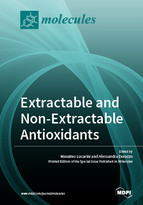Extractable and Non-Extractable Antioxidants
A special issue of Molecules (ISSN 1420-3049). This special issue belongs to the section "Natural Products Chemistry".
Deadline for manuscript submissions: closed (31 October 2018) | Viewed by 86425
Special Issue Editors
Interests: bioactive compounds; natural products; nutraceuticals; antioxidants; dietary supplements; food quality; nutrition; food composition databases; bioavailability, metabolic pathway; nanoformulations
Special Issues, Collections and Topics in MDPI journals
Interests: natural compounds; nutraceuticals; natural products; food science and nutrition; food composition databases; bioaccesibility; dietary intake
Special Issues, Collections and Topics in MDPI journals
Special Issue Information
Dear Colleagues,
The delineation and exploitation of extractable and non-extractable antioxidants in the main food groups, as well as by-products and biomass waste, are required. The focus should be addressed towards the description and updating of the methodological approach of antioxidant compounds in a multidisciplinary and innovative design. Conventional procedures and advanced extraction technologies, as well as analytical techniques, with particular attention to green procedures, will be considered. The combination of emerging analytical techniques and the application of statistical methods, i.e., infrared spectroscopy, multi-elemental analysis, isotopic ratio mass spectrometry, and nanotechnologies coupled with chemometrics are welcome.
The application of studies of extractable and non-extractable antioxidants on food waste, in line with concepts of circular economy and biorefineries, will be considered.
The utilization of extractable and non-extractable antioxidants in the nutraceuticals field is another focal point of this Special Issue: extracts, fractions, purified and semi-purified substances, used alone or in combination with other ingredients as dietary supplements or functional foods. This field needs to be explored using rigorous science approaches, considering a combination of studies from different fields (nutrition, food chemistry, medicine, etc.) is increasing.
Dr. Alessandra DurazzoDr. Massimo Lucarini
Guest Editors
Manuscript Submission Information
Manuscripts should be submitted online at www.mdpi.com by registering and logging in to this website. Once you are registered, click here to go to the submission form. Manuscripts can be submitted until the deadline. All submissions that pass pre-check are peer-reviewed. Accepted papers will be published continuously in the journal (as soon as accepted) and will be listed together on the special issue website. Research articles, review articles as well as short communications are invited. For planned papers, a title and short abstract (about 100 words) can be sent to the Editorial Office for announcement on this website.
Submitted manuscripts should not have been published previously, nor be under consideration for publication elsewhere (except conference proceedings papers). All manuscripts are thoroughly refereed through a single-blind peer-review process. A guide for authors and other relevant information for submission of manuscripts is available on the Instructions for Authors page. Molecules is an international peer-reviewed open access semimonthly journal published by MDPI.
Please visit the Instructions for Authors page before submitting a manuscript. The Article Processing Charge (APC) for publication in this open access journal is 2700 CHF (Swiss Francs). Submitted papers should be well formatted and use good English. Authors may use MDPI's English editing service prior to publication or during author revisions.
Keywords
- extractable and non-extractable antioxidants
- antioxidant properties
- integrated food research
- food matrices
- by-products
- food waste
- biomass
- methodological approach
- advanced technologies
- green procedures
- chemometrics
- biorefinery
- nutraceuticals
- dietary supplements
- functional foods








